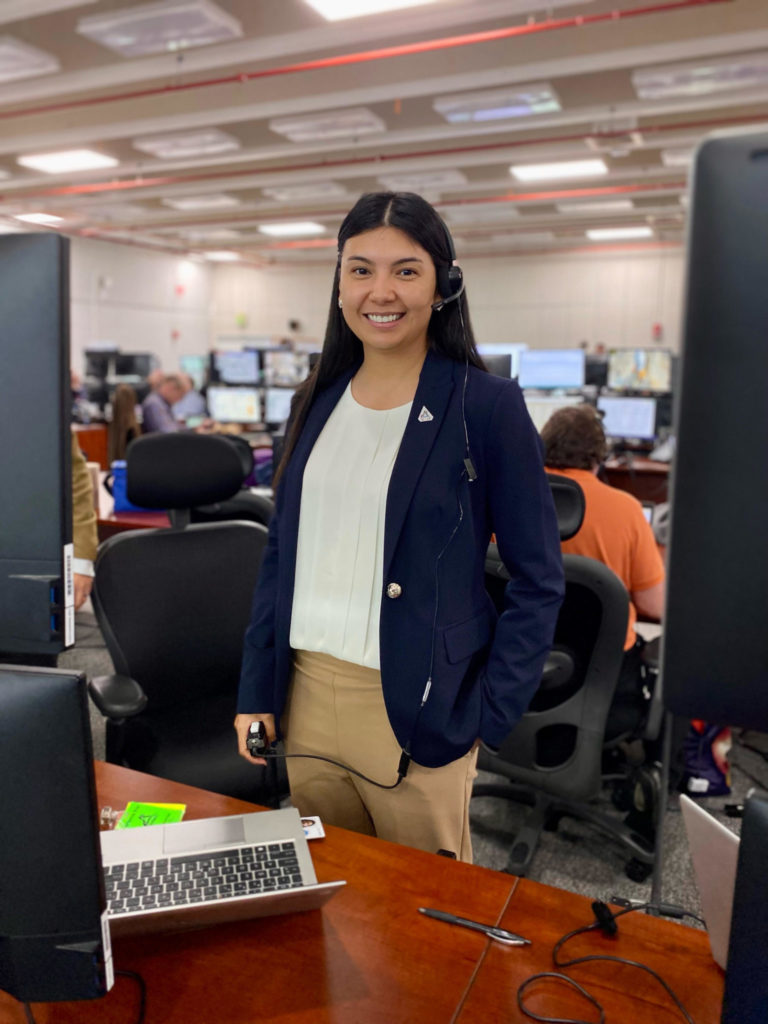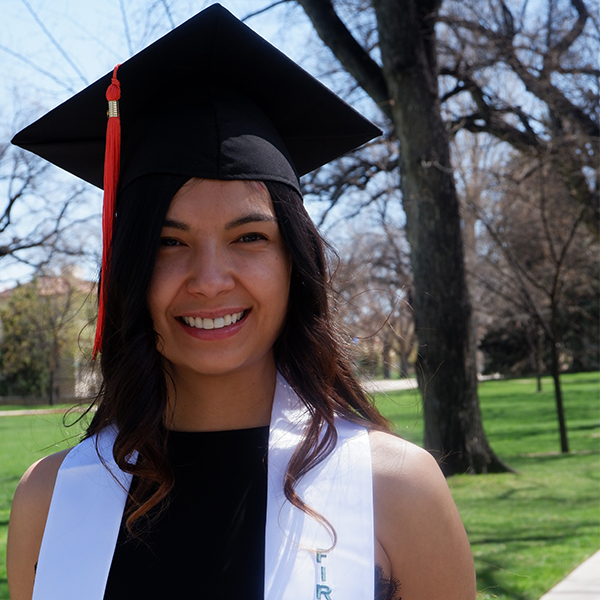
For those who knew Danelle Lazcano-Concelman (Mechanical Engineering, ’20) while she was at CSU, it’s no surprise that her career is taking off like a rocket. She was a project manager for the CSU Rocket Team, one of the first teams nationally to switch from solid propellants to more complex liquid fuel systems. She completed four NASA internships during her time here, which she says helped provide the focus and motivation to excel in a demanding academic program.
Engineering SOURCE caught up with her just after splash-down of the Artemis I lunar mission in mid-December to talk about her experience.
Congratulations on a successful mission!

Thank you so much!
Can you explain your role on Artemis 1?
Yes, I work with the liquid oxygen subsystem. It’s the oxidizer that mixes with the fuel to give the rocket propulsion to head towards the moon. I’ve been here for two years full time, and I did three rotations as a Pathways student when I was at CSU.
This mission famously ran into a few launch delays. Those must have been very hard, emotionally, but also technically, since you work in cryogenic propulsion.
Something that I learned quite quickly in the industry is that sometimes in the real world there are just these unexpected challenges. But as an engineer, that’s something that we learn to overcome and put our brain power together to solve some really big issues. Every training scenario that we’ve had was essentially, try to throw problems at the team so that they’re prepared for anything that might come up. That helps you mentally prepare because you know sometimes things aren’t going to go as you want them to.
Our first attempt, we had a lot of issues. Hydrogen, being the smallest atom, is very hard to contain, and it’s at these very cold temperatures. The leak was something that we’ve noticed and overcome in the Space Shuttle program. And with the experience of those who did stay around from Shuttle days, we were able to feel a little bit more reassurance that this is something we can figure out. Of course, our team is dealing with a new vehicle, and so with that came a lot of things that we’re taking note of, collecting data. So although we didn’t get to launch on the first or second attempt, we did obtain a lot of new information about how this vehicle operates, how to optimize our cryogenic filling operations, and that’s something we value nonetheless.
Can you describe the feeling in the room during the big milestones of the mission?
On the third attempt, we come in…. It’s late at night, you’re trying to keep the energy high, and at this point you’re going into a third shift (11 p.m. to 7 a.m.), which is hard after doing three days of preps. Of course, you’re also super excited.
Liquid oxygen did not have any problems when I arrived, hydrogen was going along smoothly, we had overcome some of the first hurdles that we experienced in the first two launches, and everybody was hopeful.
There was a valve that was not communicating properly. The launch director directed us to send someone out to physically get this valve back into communication. In those moments, I was very nervous. Having personnel close to something very similar to a missile is extremely dangerous. You see these people as your friends, and they’re risking their lives to go and fix something for a larger cause.
The last ten minutes went smoothly. Everybody’s high anxiety, because you’re waiting for something to pop up – the training has always taught us something could occur. The final 30 seconds is always the biggest moment. I was trying to stay focused, but of course you’re feeling excited, you’re feeling nervous.

Once I heard “Ignition” over the intercom on my headset I started crying. You look up and the rocket is passing the building. I actually ran out of the room to look out of our big bay window, and I could see high up in the sky was the big ball of light. It was absolutely magical, because it was headed straight for the moon. It was almost like this metaphor, you know: she’s on her way, and mission complete.
I think at age 26, I felt thankful that I could be part of something bigger than myself, something that is going to be in the history books. Then it was right back to work. You have to immediately start focusing on the vehicle. You check: no leaks, no fires, you’re panning cameras to see any damage, and ever since then, we’ve been processing all of the data from the launch.
Splashdown was just the other day. Everything went perfectly once the rocket was launched, from what I understand.
We are still going to receive the vehicle to process the data. But from a vehicle standpoint, the Orion did survive, it accomplished its mission.
Just having confirmation that something you designed is working, and it did exactly what you wanted it to, that’s an engineer’s dream. Something we strive for every day.
If you had to pick one equation that governs the work that you do, what would you pick?
There’s a funny story. We have to adjust our pressure transducers to the proper units we can use. As an intern, I was trying to understand how we tell the software to translate these values. I had used y =mx+b [the equation for the slope of a line] as a first guess. It’s that equation, like, when am I ever gonna use this? As an intern, it was just a joke. And now that I’m here officially, I go into the scaling to look at something, and what do you know, it’s this equation, and they’re like, “Oh, yeah, that’s how we scale our sensors here.” Something you think is so trivial and simple is actually very important when it comes to these big missions.
All the little details matter. To see that come full circle was such a treat. Although things might seem trivial when you’re in college, and your professors might repeat something over and over and you think, “Oh, it’s not going to show up in the real world,” it really does.
A callback to Algebra I.
Yeah, it’s the simple stuff (laughs).
NASA has a reputation as a high-pressure environment. Is there anything you’ve learned since starting at NASA that helps you get the most out of yourself?
Training is a huge part of it. You also have this heritage knowledge from our Shuttle folks, who come in and say, “This is the problem, I’ve seen this before.” And having that heritage knowledge when you’re a young engineer is a big part of your training. You’re looking for textbook things when you first start out, and you’re assuming that the problems will be much like the problems you got on homework. Having these folks who’ve been around, it teaches you how to see the problem a little bit differently.
People in different departments, different teams, we all come together with what we believe is going on. Instead of just assuming it’s gonna be very straightforward, we look at all different options, we talk about it, and we bring in knowledge from the past to possibly help us with the future.
Has anything that you’ve experienced working at NASA influenced your perspective looking back on your education at CSU?

Oh, tremendously. I think the opportunity to go out and work in the real world and then come back into a school environment. … One, you appreciate not having to do homework after 5:00 or 6:00 p.m. (laughs). But other than that, you get to see how concepts are going to be applied.
When I first went to NASA as an intern, I was working in the valves department, wondering, like, “What are valves going to do for me? This is such a specific thing.” But I wasn’t going to turn down a NASA opportunity, so I go in, I learn as much as I possibly can, and it turns out everything I do now in my job relies on these valves.
Of course, we don’t have a valve class (at CSU), but it came down to fluids, and thermodynamics. You also need to understand data acquisition, because we need to understand how things are operating in the real world, and those fundamentals really do come together to help you understand these bigger, more complex problems. Engineering is very difficult, but after sophomore year it started clicking because I was able to use real-world examples to help me think through what this homework problem was trying to accomplish.
And of course, the biggest lesson is that nothing is perfect. When something works perfectly, it’s almost like “Wait, how does that happen?” But at NASA, we need it to be 100% all of the time. It’s just one of those things where I think I excelled in my education after returning. I do remember getting a lot better grades my senior year, because it changes it for you. After a lot of years [in school] consecutively it gets a little harder to stay focused. But being able to experience what you’re going to do in the future helps you kind of stay motivated, saying “This is all going to be worth it.” And you want that inspiration because it makes all of your designs, all of your products better.
What’s next for you? Are you going to be involved in future Artemis missions as we start sending human astronauts back to the moon?
Yes! I do have this fear that, oh my goodness, I’m going to be helping to launch human beings off the planet Earth! But I am excited.
We are already moving forward. I’ve been blessed to have the opportunity to help with ML2, and we’ll have another cooling system that we’re building now. It’s one of those things where I hope to say that I was there from the beginning to the end. A lot of people here have gone through many missions. That is just something that makes it feel so wholesome, dedicating 40 years to making history, and I hope to do the same.